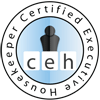Degreasers come in many forms, from mild to heavy duty. Dishwashing liquid is an excellent mild degreaser that has a number of uses throughout the kitchen and beyond, and most brands are specifically formulated to be easy on your hands. Commercially available products such as Fantastik or Formula 409 will handle tougher degreasing jobs while remaining suitable for everyday household use (some of these degreasers may contain toxic solvents or glycol ethers such as 2-butoxyethanol, so you may want to opt for a greener alternative: see also green cleaning.)
entry continues below ↓
At the harsh end of the scale,
lye is a caustic degreaser best suited for the most extreme tasks.
Lye, whose most familiar use is in oven and
drain cleaners, is toxic to ingest and its vapors are highly irritating to breathe. It will also burn skin quickly. If you must resort to using any product containing lye, it is essential to use
rubber gloves, a breathing mask and other skin and
eye protection. It should go without saying that lye must be stored out of the reach of children.
Degreasing typically will require the use of mechanical action, but in a number of cleaning tasks, it’s best to let the liquid sit on the greasy surface for several minutes before wiping or scrubbing. Remember that a lot of finished surfaces can be scratched or damaged by scrubbing with abrasive cleaning tools. Always start out gently, using a
sponge or cloth, before resorting to more aggressive tactics.
Degreaser: Created on November 3rd, 2009. Last Modified on January 1st, 2010
References listed above credit sources The Housekeeping Channel consulted for background or additional information.
All HC-PediaTM content is © 2005-2025 The Housekeeping Channel.
Except for third-party copyrighted material, you may freely use, excerpt or cite this material provided The Housekeeping Channel receives credit and the Web address www.housekeepingchannel.com is plainly listed with all uses, excerpts or citations.









